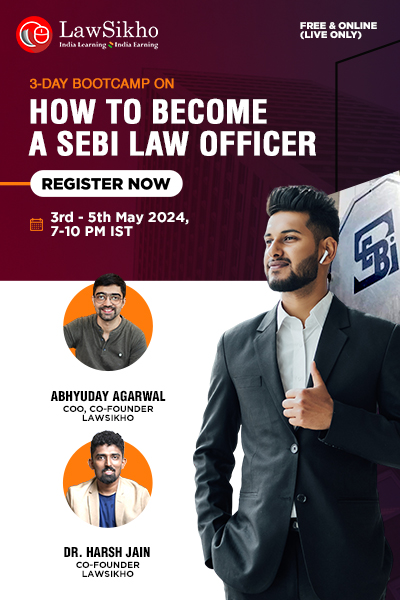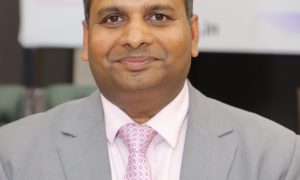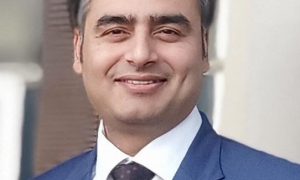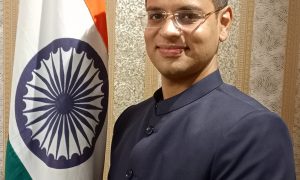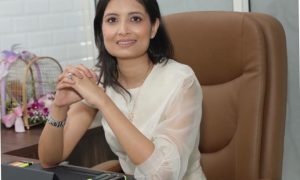This interview has been published by Priyanka Karwa and The SuperLawyer Team
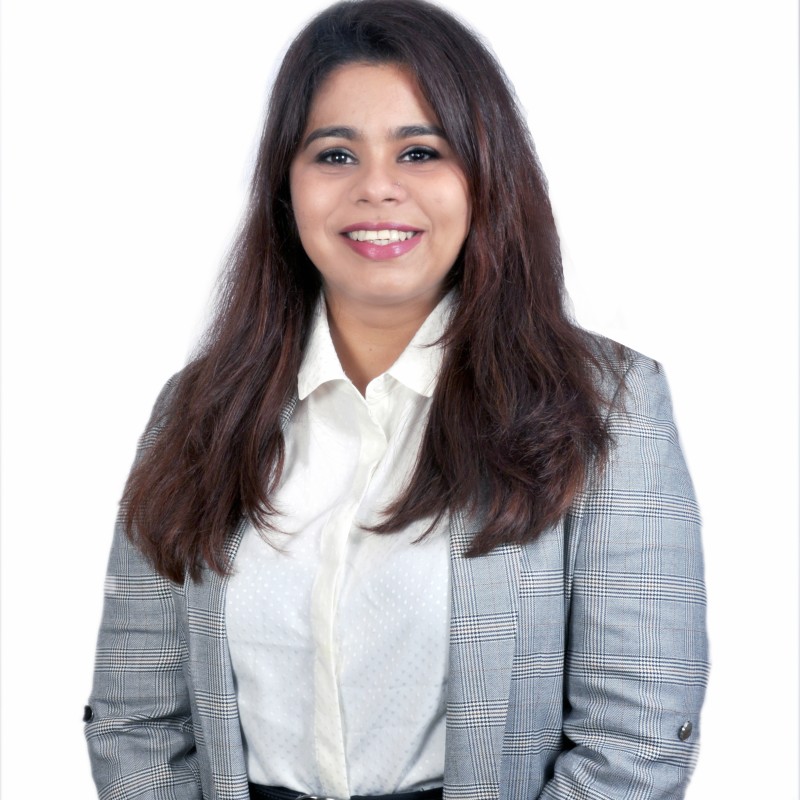
Can you share the story of how you decided to pursue a career in law, and what inspired you to become a lawyer?
Well, my journey into the field of law was greatly influenced by my family’s legacy of distinguished lawyers, particularly my maternal grandfather, Mr. Gyan Chandra Dwivedi. He was a Senior Advocate at the High Court of Judicature at Allahabad and a true luminary in the legal world. His reputation for his commitment to justice and his impact on people’s lives left an enduring impression on me.
As a child, I often found myself intrigued by the stories and discussions about legal cases that echoed through our family gatherings. These conversations weren’t just about courtroom dramas; they were about real people’s lives being shaped and justice being served. The more I heard, the more I felt drawn to the idea of becoming a lawyer.
After finishing school, I decided to follow this innate calling and embarked on my journey towards a career in law. I got myself enrolled in a B.B.A. LLB (Hons) program at Amity University, Uttar Pradesh. This was the first step in the realization of my passion for the legal profession.
However, the pivotal moment in my journey came during my second year of law school when I had the opportunity to intern with the Human Rights Law Network (H.R.L.N.) in Allahabad. It was during this internship that I got a taste of what it truly means to be a lawyer.
One particular case during this internship became a turning point in my life. I was entrusted with the responsibility of drafting and arguing a Public Interest Litigation (PIL) seeking a ban on the sale of acid in Uttar Pradesh. This was not just a case but a chance to bring about tangible and positive change in society.
The day came when I had to stand before the court and present our case. To my surprise and honour, the case was heard by the now Chief Justice of India, Justice D.Y. Chandrachud, who was then presiding in Allahabad High Court along with Justice Harcauli. My heart raced as I presented our case, knowing that it had the potential to make a difference in the lives of countless people.
The order came in our favour, whereby the CMO of Allahabad was directed to ensure that medical aid (bed in the severely burned ward) be provided to the acid attack victim immediately. Further, Justice Chandrachud’s kind words of appreciation for our efforts were incredibly encouraging. This experience was profoundly enriching and reinforced my passion for law. It showcased the immense potential law holds to bring about positive change in society and ensure justice is served.
From that moment on, my commitment to the legal profession deepened, and I knew that I was on the right path. It was a journey driven by my family’s legacy and fuelled by the desire to make a meaningful contribution to the world through the pursuit of justice.
Today, as a lawyer and Managing Partner at Sinha & Partners, Advocates and Solicitors, I continue to be inspired by the values instilled in me by my family and the belief that law has the power to transform lives and society for the better. This is the story of how I found my calling in the world of law, and it’s a journey I cherish every day.
Can you walk us through some key milestones and experiences that shaped your legal career?
Certainly, let me take you on a journey through some key milestones and experiences that have profoundly shaped my legal career.
One of the pivotal moments in my career came when I had the opportunity to argue a case of medical negligence. It was a case that not only tested my legal acumen but also my dedication to seeking justice for my client. The District Forum passed a judgment in our favor, holding the doctors and hospital guilty of medical negligence and unfair trade practice. It was a significant victory, but the journey was far from over.
The case was subsequently challenged before the State Commission, where we faced a setback. The appeal was allowed, based on an erroneous finding by the State Commission. It was a moment of adversity, but it only fuelled my determination. I decided to challenge the State Commission’s order and sought revision before the National Consumer Dispute Redressal Commission.
This was a critical juncture in my career, and it required unwavering perseverance. After a rigorous legal battle, the National Consumer Dispute Redressal Commission ultimately passed judgment in favor of my client. It was a sweet victory that reaffirmed my belief in the legal system’s ability to right wrongs.
Another significant milestone in my journey was when I successfully had an award passed by a Sole Arbitrator set aside under Section 34 of the Arbitration and Conciliation Act, 1996. The circumstances surrounding this case were unique and challenging. The award had erroneously granted rent to the landlord for a commercial property during the lockdown imposed due to the COVID-19 pandemic.
The legal battle that followed was intense, but it led to a groundbreaking decision by the Hon’ble High Court. The court ruled that COVID-19 constituted a force majeure event, and invoking the force majeure clause during such times was both valid and legal. It was a significant precedent that not only benefited my client but also had broader implications for legal interpretations during unprecedented events.
In another instance, I managed to halt the initiation of the Corporate Insolvency Resolution Process (CIRP) after the first meeting of the Committee of Creditors (CoC). This achievement was the result of a strategic settlement between the Corporate Debtor and the Creditor. It was a testament to the power of negotiation and finding common ground in the often-complex world of insolvency proceedings.
These milestones and experiences have played a crucial role in shaping my legal career. They have instilled in me a deep sense of commitment to delivering excellence in the legal profession. They have also equipped me with the skills and determination needed to navigate the intricate and challenging legal landscapes that continue to unfold before me.
As the Managing Partner at Sinha & Partners, you’ve navigated complex legal landscapes. Could you share an example of a particularly challenging case or situation you’ve encountered and how you successfully handled it?
There are several challenging situations which I encountered during my tenure as the Managing Partner at Sinha & Partners. It is a complex legal landscape, and the stakes are extremely high.
Let me share one of such many cases. The case involved a multinational corporation embroiled in a protracted contractual dispute with a key business partner. The dispute was multi-faceted, spanning several jurisdictions and involving significant financial interests. Our client was facing the risk of substantial financial losses and damage to its reputation if the dispute wasn’t resolved favorably.
Navigating this complex situation required a multi-pronged approach. Here’s how we tackled it:
Thorough Analysis: The first step was an in-depth analysis of the contractual agreements, relevant laws, and the nuances of the dispute. This involved a meticulous review of documents and a deep understanding of the client’s business operations.
Strategy Development: Based on our analysis, we crafted a comprehensive legal strategy. This included identifying potential weaknesses in the opposing party’s arguments and formulating strong counterarguments.
Multi-Jurisdictional Coordination: Given the international aspects of the dispute, we coordinated with legal experts and partners in various jurisdictions to ensure a cohesive approach. Clear communication and strategic alignment were paramount.
Negotiation and Mediation: Recognizing the potential benefits of an amicable resolution, we engaged in extensive negotiation and mediation efforts. This required maintaining a delicate balance between asserting our client’s rights and exploring settlement options.
Litigation Preparedness: Simultaneously, we prepared for potential litigation. This involved gathering evidence, identifying key witnesses, and ensuring our legal team was ready for courtroom proceedings.
Client Communication: Throughout the process, we maintained open and transparent communication with our client. We provided regular updates on the progress of the case and discussed potential scenarios and their implications.
After months of intense negotiations and legal manoeuvring, we achieved a favorable settlement for our client. The agreement not only safeguarded their financial interests but also included provisions to protect their reputation and ongoing business relationships.
This case taught me several valuable lessons. It emphasized the importance of meticulous preparation, strategic thinking, and effective communication. It also underscored the significance of flexibility and adaptability in the face of evolving circumstances.
Ultimately, successfully handling this complex case was a team effort, and it showcased the dedication and expertise of our legal team at Sinha & Partners. It reinforced our commitment to delivering exceptional results for our clients, even in the most challenging legal landscapes.
During your time as an External Member of the Internal Complaint Committee under the Sexual Harassment of Women at Workplace Act, what have been some of the most important lessons you’ve learned about workplace compliance and gender equality?
Certainly, let me share my experiences during my time as an External Member of the Internal Complaint Committee under the Sexual Harassment of Women at Workplace Act. It’s been a journey filled with valuable lessons about workplace compliance and gender equality.
Picture this – I found myself in a unique position, serving as an External Member on the Committee. From the very beginning, it was evident that empathy plays a pivotal role in addressing workplace harassment cases. Hearing the survivors’ stories and understanding their experiences first hand made me realize the profound impact empathy can have. It’s not just a professional duty; it’s about creating a safe and supportive space where survivors can find solace and trust the process.
One of the standout lessons was the importance of proactive prevention. It’s not enough to have policies in place; it’s about fostering a culture of respect and equality within the workplace. When employees feel genuinely valued and respected, issues are less likely to surface in the first place. Prevention truly is worth its weight in gold.
Then came the realization that fair procedures are the bedrock of any effective complaint resolution process. The investigations must be thorough, impartial, and swift. This ensures justice for all parties involved and maintains trust in the system.
Education emerged as a key component. Many employees, I discovered, weren’t fully aware of their rights or what constituted harassment. Educating the workforce about these critical matters proved to be pivotal. Knowledge empowers individuals to recognize and report inappropriate behaviour, fostering a safer working environment.
Perhaps one of the most resounding lessons was the unequivocal stance against retaliation. It was abundantly clear that employees should feel safe and secure when
coming forward with complaints. Fear of repercussions should have no place in such a scenario.
And then there was the understanding that gender equality isn’t the sole responsibility of one gender. It’s a collective effort that requires both men and women to champion equality in the workplace. Everyone must play their part.
Lastly, the journey underscored that workplace compliance and gender equality are not one-time achievements. They demand continuous improvement. Regularly revisiting and enhancing policies and practices is the key to creating a better work environment.
In summary, serving as an External Member of an Internal Complaint Committee of an organisation is a profound experience that reinforced the significance of active commitment, empathy, and an unceasing pursuit of improvement in creating a truly inclusive and safe workplace for all. It’s a journey we should all embark upon together, because, in the end, it’s about justice, respect, and equality for everyone.
Your expertise includes Commercial Litigation and Corporate Compliance. Could you provide insights into the intersection of these two areas and how they impact businesses in today’s legal environment?
Commercial litigation and corporate compliance—it’s like a dynamic dance, and let me share some insights into how they tango in today’s legal landscape:
Risk Mitigation: Picture this as your shield in the legal battlefield. Strong corporate compliance practices are your first line of defense. They’re all about making sure your business plays by the rules and stays on the right side of the law. Why? Because when you’re compliant, you’re mitigating the risk of legal disputes. It’s like having an insurance policy against lawsuits.
Dispute Resolution: But hey, life’s not always a smooth sail. Disputes happen, and when they do, your compliance practices and records can be your knight in shining armor. They’re crucial in defending your actions and minimizing any potential legal liabilities. It’s like having a well-prepared strategy for a chess match.
Contractual Compliance: Ever heard the phrase, “It’s all in the fine print”? Well, in commercial litigation, it often is. Many cases revolve around contractual disputes. So, if you’ve diligently adhered to your contractual obligations, you’re in a much better position to steer clear of litigation storms. It’s like ensuring everyone’s on the same page.
Regulatory Changes: The legal landscape is like a moving target—regulations change, and they change fast. Staying updated on these changes and adapting your compliance practices accordingly is like navigating a constantly shifting maze. It’s a must to reduce the chances of legal headaches down the road.
Reputation Management: In today’s hyperconnected world, your reputation is gold. Effective compliance and litigation management are like your guardians of
reputation. They not only keep you out of trouble but also safeguard your company’s image. And in business, that’s priceless.
So, there you have it—commercial litigation and corporate compliance, two sides of the same coin in today’s legal arena. Together, they help businesses thrive while minimizing the legal hiccups that can trip you up along the way. It’s all about keeping the dance smooth and in harmony.
You have experience representing clients before different courts and forums in Delhi NCR. Can you share some valuable tips for young lawyers on effective courtroom advocacy and client representation?
Absolutely, I’d be happy to offer some practical advice for young lawyers when it comes to effective courtroom advocacy and client representation:
Thorough Preparation: Before stepping into the courtroom, invest ample time in thoroughly understanding your case, including the legal aspects, relevant precedents, and the key facts. Anticipate potential arguments from the opposing side, and be ready with well-researched counterarguments.
Confidence and Professionalism: Maintain a confident demeanour while always upholding the highest standards of professionalism. This includes how you interact with both the court and your clients. Confidence can inspire trust in your clients and convey competence to the court.
Effective Communication: When presenting your case, aim for clear and concise communication. Avoid using legal jargon that might confuse your clients or the court. Ensure that your client fully comprehends the proceedings, and be ready to explain legal matters in plain language.
Active Listening: Actively listen to your client’s concerns and questions. Keeping your clients well-informed about the progress of their case is vital. Address their queries promptly and provide updates on the developments in their legal matter.
Adaptability: Be flexible in your approach. Legal proceedings can take unexpected turns, so always be prepared to adapt your strategy and arguments if the circumstances change during the case. This flexibility can be a key asset in achieving the best possible outcome for your client.
Ethical Practice: Uphold the highest ethical standards in all your interactions and actions. Your reputation for integrity is one of your most valuable assets as a lawyer. Always act in the best interests of your clients while adhering to ethical guidelines and professional conduct.
Mentorship: Seek out experienced lawyers who can serve as mentors. Learning from their insights and experiences can be incredibly valuable as you navigate the complexities of legal practice. A mentor can provide guidance, share practical knowledge, and help you grow as a legal professional.
Remember that effective courtroom advocacy and client representation are skills that develop over time with experience and continuous learning. Stay dedicated to honing these skills, and you’ll be better equipped to serve your clients and achieve success in your legal career
When it comes to dealing with the Companies Act, 2013, I’ve seen firsthand how it can get pretty complex. Businesses often encounter some common challenges, and here’s my take on it:
Regulatory Changes: This act is like a chameleon—it’s always changing its colors.
Frequent amendments and updates keep rolling in, and businesses need to stay on their
toes to keep up. It’s like trying to catch a moving target.
Corporate Governance: Proper corporate governance is crucial, but it’s not always a walk in the park. It involves things like making sure board meetings are held as required and disclosures are made accurately. Sometimes, it feels like juggling multiple balls in the air.
Financial Reporting: Ah, financial reporting! This one’s a classic challenge. It’s not just about numbers; it’s about getting them right, auditing them thoroughly, and filing them on time. It’s like a high-stakes game of financial precision.
Related-Party Transactions: Compliance with regulations on related-party transactions can be quite a puzzle. It’s a delicate balancing act, and one wrong move can lead to trouble. Managing these intricacies is key.
Compliance Documentation: Let’s not forget about the paperwork. Maintaining meticulous records and documentation is critical. It’s like building a paper trail that stands up to scrutiny.
So, how do I lend a hand to businesses dealing with these challenges? Well, I like to be proactive. I offer compliance solutions that are ahead of the curve, conduct thorough compliance audits, and provide guidance that helps businesses navigate the Companies Act, 2013, and all its intricacies. It’s all about making sure they stay on the right side of the law while they focus on their core operations
Finally, for fresh graduates aspiring to pursue a career in law, what advice would you offer based on your own experiences and growth in the legal field?
To fresh graduates with dreams of embarking on a legal career, I’ve got some advice based on my own experiences and growth in the legal field:
First and foremost, nurture a true passion for the law and a steadfast dedication to the pursuit of justice. Trust me, it’s this passion that will be your unwavering ally when you face the inevitable challenges along the way.
Secondly, you have to be in the process of continuous learning as the legal world is like a dynamic river; it never stops moving. So, make a pact with yourself to be a lifelong learner. Stay curious, stay hungry for knowledge, and keep an eagle eye on
legal developments, including the latest case law and legislative changes. This knowledge is your secret weapon for excelling in your practice and serving your clients with excellence.
Finally, I could not stress more on the power of connections. Take the time to build relationships within the legal community. It’s not just about collecting business cards; it’s about forging genuine connections with fellow lawyers, mentors, and seasoned practitioners. These connections can work wonders, opening doors to exciting opportunities and valuable mentorship that can fast-track your journey in the legal profession.
Remember, the path you’re embarking on is both challenging and incredibly rewarding. With passion, continuous learning, and a well-nurtured network, you’ll not only navigate this path but also thrive in the world of law. Best of luck on your exciting journey ahead!
Get in touch with Shivee Pandey Sinha-

